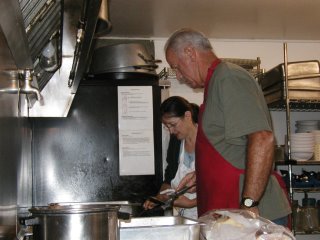 Two lessons emerged from my first year as chef for Northern California FC Camp. I knew that to keep my sanity (and bring my work-day under 12 hours), I had to train my staff and provide a pleasant work environment for the staff. After all, most of us use vacation time from work. By year two, I was able to let go of some of my cooking duties and focus on leadership.
Two lessons emerged from my first year as chef for Northern California FC Camp. I knew that to keep my sanity (and bring my work-day under 12 hours), I had to train my staff and provide a pleasant work environment for the staff. After all, most of us use vacation time from work. By year two, I was able to let go of some of my cooking duties and focus on leadership.I now believe the most important lesson was the realization that I had to change my menu writing ways if I was to keep year-to-year turnover to a minimum. Turnover of kitchen staff didn’t level out until last year (the forth year). It took me three years to develop a menu that satisfied my desire to prepare scratched-cooked food, temper the long work days and make use of volunteers who don’t have professional cooking experience.
When my staff kept asking me “Can I come back next year?” last July, I knew that I had met my three-fold test. I attribute this to purchasing a balanced mix of raw ingredients and ready-to-use food. (To be fair, a liberal food budget and a former director’s keen ability to recruit quality volunteers also played a role.)
Volunteer staff have a tendency to give you the “1,000-potato stare” when the produce man unloads three burlap sacks of Idaho’s finest potatoes. The musty sacks can only mean one thing: a potato-peeling party. (And don’t forget my wrestling match with the mandoline.)
Frozen hash browns, dehydrated scalloped potatoes and par-cooked red potatoes are acceptable substitutes for fresh. I’ve purchased the hash browns from year-one. From the beginning, I didn’t have a desire to shred 40 pounds of potatoes by hand (Daybreak has few electric appliances). I introduced the scallops and the reds last year. Both are wonderful products and great timesavers.
Finding the balance between scratch cooking and ready-to-use products
 You have to determine which products are best scratch cooked for your menu. I place the focus on several signature items, like my 4 a.m. cinnamon rolls. This breakfast takes me back to my Navy days when I was a baker. I enjoy getting up at oh-dark-thirty one morning to set the rich sweet dough. (The quite morning is punctuated by the deer grazing in the mist of morning sprinklers.)
You have to determine which products are best scratch cooked for your menu. I place the focus on several signature items, like my 4 a.m. cinnamon rolls. This breakfast takes me back to my Navy days when I was a baker. I enjoy getting up at oh-dark-thirty one morning to set the rich sweet dough. (The quite morning is punctuated by the deer grazing in the mist of morning sprinklers.)I purchase ready-to-use items for several reasons. Many are purchased purely for convenience. Campers are familiar with imitation maple syrup and bottle Kraft barbecue sauce. I could prepare superior syrup or barbecue sauce from scratch. But I don’t have the time, nor the inclination to add a dozen ingredients to the inventory.
Chef-choice cookies (chocolate chip are winners -- don’t waste your time on oatmeal raisin) were featured on the lunch menu until 2003. Then last year I purchased Sysco cookie mix and chocolate chips. At the suggestion of staff we baked sheet pan chocolate chip “brownie” bars on Monday, Wednesday and Friday. I had found an easy-to-prepare product that the kids loved (so much so that my dining room host assigned an adult monitor to ration the cookies!).
I do have limitations. I draw the line at frozen lasagna and frozen French toast or pancakes. They save time. But we’ve had four years to practice these menu items. My second cook is an expert lasagna maker. As soon as the sauce is ready, filling mixed and cheeses grated, a four or five person team can build eight shallow hotel pans of lasagna in less than an hour.
And I think it’s a culinary misdemeanor to waste your food dollar on frozen pancakes or French toast. Scratch-made breakfast staples are superior to their ready-to-cook cousins. I could use a quality pancake mix (Kusteaz is among the best). But I’ve been mixing Armed Forces recipe number D-25 for more than three decades. It’s engraved in my brain -- so why change now? (Don’t get me started on frozen waffles -- too many bad experiences from my large institutional kitchen job!)
The key is to take my example of a working camp menu write your own. Your campers may bring a different set of culinary experiences to the dining room table. With a little practice, you’ll find the right mix of scratch items and store-bought foods.
To be continued ...


No comments:
Post a Comment